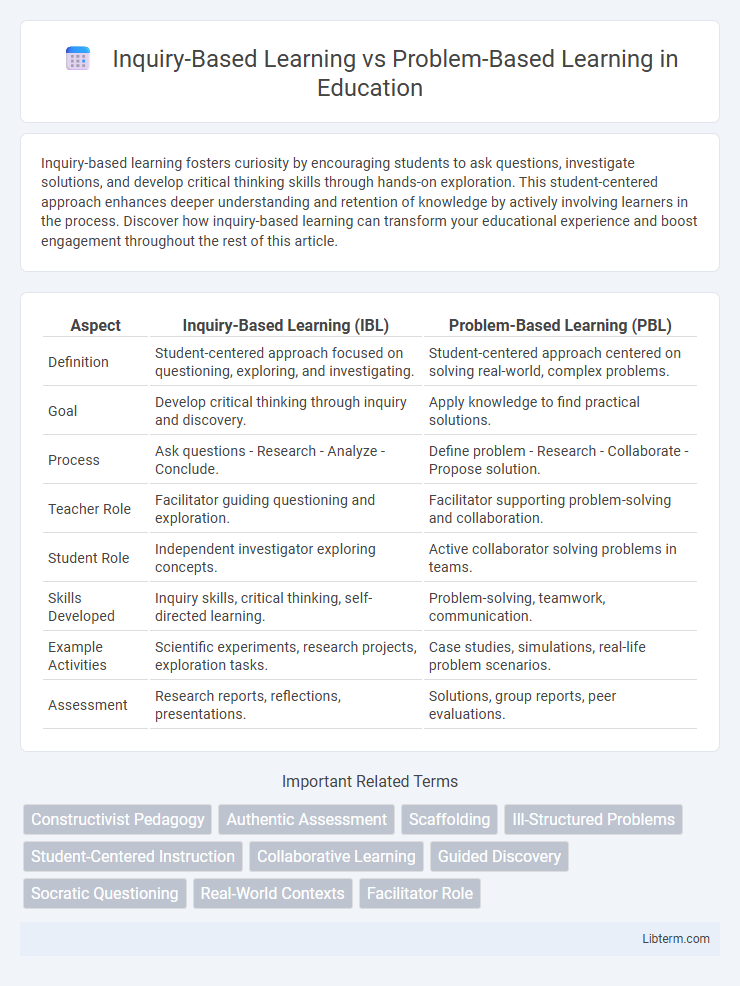Inquiry-based learning fosters curiosity by encouraging students to ask questions, investigate solutions, and develop critical thinking skills through hands-on exploration. This student-centered approach enhances deeper understanding and retention of knowledge by actively involving learners in the process. Discover how inquiry-based learning can transform your educational experience and boost engagement throughout the rest of this article.
Table of Comparison
| Aspect | Inquiry-Based Learning (IBL) | Problem-Based Learning (PBL) |
|---|---|---|
| Definition | Student-centered approach focused on questioning, exploring, and investigating. | Student-centered approach centered on solving real-world, complex problems. |
| Goal | Develop critical thinking through inquiry and discovery. | Apply knowledge to find practical solutions. |
| Process | Ask questions - Research - Analyze - Conclude. | Define problem - Research - Collaborate - Propose solution. |
| Teacher Role | Facilitator guiding questioning and exploration. | Facilitator supporting problem-solving and collaboration. |
| Student Role | Independent investigator exploring concepts. | Active collaborator solving problems in teams. |
| Skills Developed | Inquiry skills, critical thinking, self-directed learning. | Problem-solving, teamwork, communication. |
| Example Activities | Scientific experiments, research projects, exploration tasks. | Case studies, simulations, real-life problem scenarios. |
| Assessment | Research reports, reflections, presentations. | Solutions, group reports, peer evaluations. |
Introduction to Inquiry-Based Learning and Problem-Based Learning
Inquiry-Based Learning emphasizes active student engagement through questioning, exploration, and investigation to develop critical thinking and deeper understanding across disciplines. Problem-Based Learning centers on student collaboration to solve real-world, complex problems, fostering practical skills and applied knowledge in professional contexts. Both approaches prioritize student-centered learning but differ in focus: inquiry-driven exploration versus solution-oriented problem solving.
Defining Inquiry-Based Learning
Inquiry-Based Learning emphasizes student-driven exploration by posing questions, investigating phenomena, and constructing knowledge through active engagement and critical thinking. This pedagogical approach fosters curiosity and deep comprehension by encouraging learners to formulate hypotheses, gather evidence, and draw conclusions independently or collaboratively. Rooted in constructivist theory, Inquiry-Based Learning develops higher-order cognitive skills essential for lifelong learning and real-world problem-solving.
Defining Problem-Based Learning
Problem-Based Learning (PBL) is an instructional approach where students learn by actively solving complex, real-world problems without predetermined solutions, fostering critical thinking and self-directed inquiry. This learner-centered method emphasizes collaboration, application of interdisciplinary knowledge, and development of problem-solving skills essential for professional practice. Unlike Inquiry-Based Learning, which broadly encourages questioning and exploration, PBL is structured around a specific problem that drives the entire learning process.
Key Differences Between Inquiry-Based and Problem-Based Learning
Inquiry-Based Learning emphasizes students' exploration of open-ended questions, fostering curiosity and critical thinking through investigation and discovery. Problem-Based Learning centers on solving specific, real-world problems, promoting collaborative problem-solving skills and application of knowledge to practical scenarios. The main difference lies in Inquiry-Based Learning's focus on questioning and exploration, while Problem-Based Learning targets solution-driven collaboration and application.
Pedagogical Foundations of Each Approach
Inquiry-Based Learning is rooted in constructivist pedagogy, emphasizing student-driven exploration and questioning to build knowledge through active engagement with content. Problem-Based Learning derives from experiential learning theory, focusing on collaborative problem-solving with real-world scenarios to develop critical thinking and applied skills. Both approaches prioritize learner autonomy but differ in structure, with Inquiry-Based Learning fostering open-ended investigation and Problem-Based Learning centering on resolving specific, often complex problems.
Benefits of Inquiry-Based Learning
Inquiry-Based Learning promotes critical thinking by encouraging students to explore questions independently, fostering deeper understanding and retention of knowledge. It enhances student engagement through active participation, allowing learners to develop research and analytical skills essential for lifelong learning. This approach supports personalized learning paths, adapting to diverse learning styles and promoting curiosity-driven exploration.
Benefits of Problem-Based Learning
Problem-Based Learning (PBL) enhances critical thinking and real-world problem-solving skills by engaging students in complex, authentic issues that require collaborative teamwork and self-directed research. PBL fosters deeper understanding and retention by situating knowledge application within practical contexts, promoting active learning and motivation. This approach develops communication, adaptability, and lifelong learning skills essential for success in dynamic professional environments.
Challenges and Limitations
Inquiry-Based Learning faces challenges such as students' difficulty in formulating questions and the need for extensive teacher guidance to maintain focus. Problem-Based Learning struggles with ensuring all group members equally participate and the complexity of problems, which may overwhelm learners without sufficient prior knowledge. Both approaches require significant time investment and skilled facilitation to be effective in diverse educational settings.
Practical Applications in the Classroom
Inquiry-Based Learning engages students in exploring questions and conducting investigations to build understanding, fostering critical thinking and independent research skills. Problem-Based Learning centers on real-world challenges that require collaborative problem-solving, enhancing teamwork and application of knowledge to practical situations. Both approaches promote active learning but differ in focus--Inquiry-Based Learning emphasizes student-driven inquiry, while Problem-Based Learning targets solving specific problems through structured group efforts.
Choosing the Right Approach for Your Educational Goals
Inquiry-Based Learning emphasizes student-driven questioning and exploration to deepen understanding, making it ideal for fostering critical thinking and curiosity in scientific or humanities subjects. Problem-Based Learning centers on real-world problem solving through collaborative effort, suited for developing practical skills and application in professional or technical education. Selecting between these approaches depends on your educational goals: prioritize Inquiry-Based Learning for conceptual mastery and Problem-Based Learning for hands-on experience and teamwork development.
Inquiry-Based Learning Infographic

 libterm.com
libterm.com